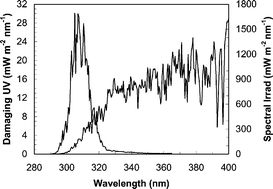Cloud and solar zenith angle (SZA) are two major factors that influence the magnitude of the biologically damaging UV (UVBD) irradiances for humans. However, the effect on the short wavelength cut-off due to SZA and due to clouds has not been investigated for biologically damaging UV for cataracts. This research aims to investigate the influence of cloud and SZA on the short wavelength cut-off of the spectral UVBD for cataracts. The spectral biologically damaging UV for cataracts on a horizontal plane was calculated by weighting the spectral UV measured with a spectroradiometer with the action spectrum for the induction of cataracts in a porcine lens. The UV spectra were obtained on an unshaded plane at a latitude of 29.5° S. The cut-off wavelength (λc) was defined as the wavelength at which the biologically damaging spectral irradiance was 0.1% of the maximum biologically damaging irradiance for that scan. For the all sky conditions, the short wavelength cut-off ranged by 12 nm for the SZA range of 5 to 80° and the maximum in the spectral UVBD ranged by 15 nm. Similarly, for the cloud free cases, the short wavelength cut-off ranged by 9 nm for the same SZA range. Although, cloud has a large influence on the magnitude of the biologically damaging UV for cataracts, the influence of cloud on the short wavelength cut-off for the biologically damaging UV for cataracts is less than the influence of the solar zenith angle.

You have access to this article
 Please wait while we load your content...
Something went wrong. Try again?
Please wait while we load your content...
Something went wrong. Try again?


 Please wait while we load your content...
Please wait while we load your content...